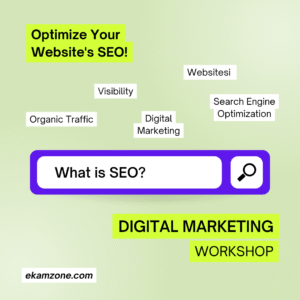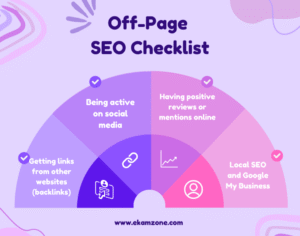Ekamzone Introducing to SEO-
Have you ever wondered how websites show up on Google when you search for something? That’s where SEO, or Search Engine Optimization, comes in. It’s all about helping your website appear in search results so more people can find you online.
In this blog, we’ll explain what SEO is, how it works, and what the good and not-so-good sides of it are.

What is SEO?

SEO stands for Search Engine Optimization. It’s a way to make your website more visible on search engines like Google, Bing, or Yahoo. The better your SEO, the higher your site can appear when someone searches for a topic related to your business or content.
Think of SEO like giving your website a map that helps search engines understand what your site is about—and how useful it is to people.
There are three main types of SEO:
Search engines like Google use special programs called bots or crawlers. These bots scan websites across the internet and add them to Google’s index (like a giant library). When someone types a search, Google uses an algorithm to decide which websites show up first.
How Does SEO Work?

Using the right keywords
Fast loading speed
Mobile-friendliness
Links from other websites (called backlinks)
Useful, clear content
Several things affect how your site ranks, including

1. On-Page SEO
This is what you do on your website. It includes:
- Writing helpful content that uses the right keywords
- Using headings and titles clearly
- Adding images with descriptive text (alt text)
- Making sure your content is easy to read

2. Off-Page SEO

This is what happens outside your website to build your reputation. It includes:
- Getting links from other websites (backlinks)
- Being active on social media
- Having positive reviews or mentions online
This is about how your website is built. It includes:
- Making sure your site loads quickly
- Securing your site with HTTPS
- Fixing broken links or pages
- Submitting your site to Google through tools like Search Console
3. Technical SEO

Merits of SEO
1. Free and Organic Website Traffic
2. Long-Term Results
SEO is a long term process, but the rewards are long lasting. Once your website have high authority and strong Google ranking it will keep bringing traffic on your site even you pose your efforts temporary. Unlike paid marketing where visitors job when the budget ends, SEO gives your website a consistent presence. A well optimised blog or post or product page can continue to generate traffic, leads, and sales for months after publishing. That’s why SEO is considered as a powerful and long term strategy for everyone looking to build a online presence specially for businesses and digital marketers
3. Builds Trust
When your site appears on the first page of Google, people naturally trust your brand more. That’s the power of good SEO. It shows users that your content is valuable, relevant, and worth their time. With strong SEO practices—like link building, well-structured content, and an informative blog—you build domain authority, which makes search engines rank you higher. Over time, this also builds trust among your audience. People are more likely to return to your site, share your content, and recommend your services when they view you as a credible source of information.
4. Better User Experience
Modern SEO is not just about adding keywords—it’s about improving the overall user experience (UX). Google rewards websites that load fast, are mobile-friendly, and are easy to navigate. When you focus on SEO, you naturally improve these areas. Optimizing images, reducing unnecessary code, and having a clean design all contribute to a better experience for your visitors. Not only do these changes help you rank higher, but they also keep users on your site longer, reduce bounce rate, and increase chances of engagement—such as clicks, shares, and purchases.
5. Attracts the Right People
SEO helps bring in the right kind of audience—people who are already searching for your products, services, or content. For example, if someone searches “best digital marketing tools for beginners” and your blog shows up, that person is already interested in what you offer. This makes SEO a highly targeted marketing strategy, which leads to better conversion rates. Instead of pushing ads to random users, SEO brings users who already have buying intent or are looking for knowledge that your site provides. This increases the chance of building a loyal audience or customer base.
Demerits of SEO
1. It Takes Time
Unlike paid ads, which can bring traffic the same day, SEO takes time to grow. It may take several weeks or even months to see your pages rank on Google, especially if you’re starting from scratch. SEO is an ongoing process that involves constant improvement—updating content, gaining backlinks, and optimizing for new search engine updates. This waiting period can be frustrating for beginners or small business owners who want immediate results. However, if you stay consistent, the long-term payoff can be more rewarding than short-term advertising campaigns.
2. Algorithm Updates Can Affect Rankings
Search engines like Google are constantly changing how they rank websites. These algorithm updates can sometimes drastically impact your website’s traffic and rankings—even if you’ve done everything right. A sudden drop in rankings after a core update may require technical fixes, content updates, or a complete strategy shift. If you’re not staying up to date with the latest SEO trends and algorithm changes, your rankings could fall overnight. That’s why SEO is not a one-time task—it requires continuous learning and adjustment.
High Competition in Popular Niches
If you’re trying to rank for highly competitive keywords like “best smartphones” or “digital marketing course,” you’ll face stiff competition from big brands and websites with strong domain authority. Competing with them requires more than just good content—it needs advanced SEO, quality backlinks, technical fixes, and time. This makes it difficult for new websites or solo bloggers to rank high quickly. Instead, focusing on long-tail keywords and niche content is often a better and more realistic SEO strategy for beginners.
4. SEO Can Be Technically Challenging
Basic SEO like keyword usage and writing meta descriptions is easy to learn. But as your website grows, technical SEO becomes more important. This includes tasks like improving site speed, setting up structured data (schema), fixing crawl errors, handling redirects, and optimizing for Core Web Vitals. Without some technical knowledge—or help from an SEO expert—you might miss opportunities to improve your site’s performance. Learning and managing all of this on your own can feel overwhelming, especially if you’re also handling content, marketing, or design.
5. No Guarantees
Even with the best content and perfectly optimized pages, there is no guarantee that your site will reach the first page of Google. There are many factors—like domain age, competition, backlink quality, and Google’s own algorithm—that affect rankings. SEO is not a magic solution; it’s a long-term commitment with no promises. You could invest a lot of time and still struggle to reach your target position. However, even small SEO improvements can lead to better traffic and visibility over time, which makes it worth the effort.
Conclusion
SEO is one of the best ways to help people find your website without paying for ads. It can take time and effort, but the results are worth it. If you want more people to visit your site, learn about your business, or buy your products—SEO is the way to go.
